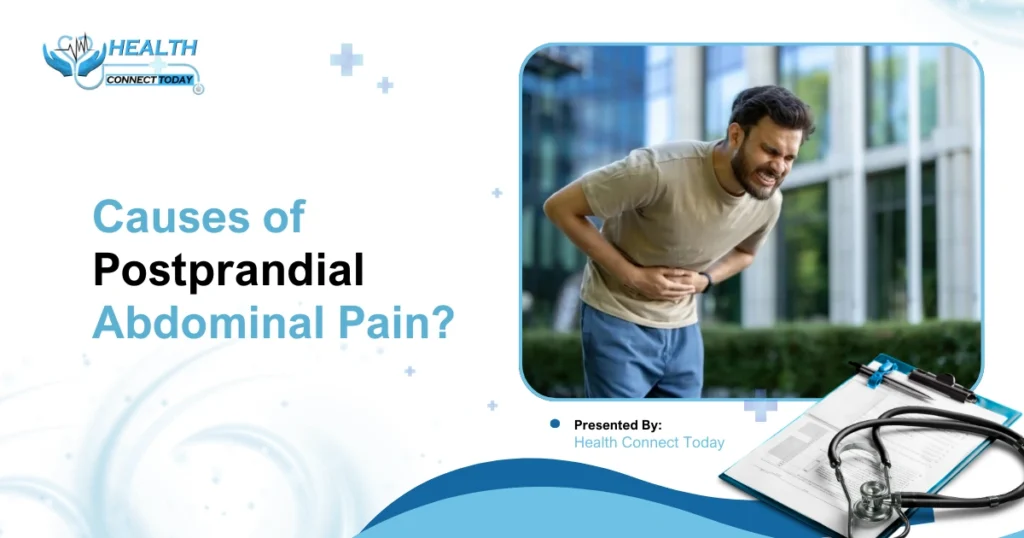Postprandial abdominal pain is a common issue that many people experience after eating. This condition is more commonly known as postprandial discomfort and ranges from slight discomfort to severe pain, which worsens the impact on daily life and general well-being. In this blog, we will be discussing what postprandial abdominal pain is, its possible causes, and available treatments.
What is Postprandial Abdominal Pain?
Postprandial pain is defined as the discomfort or pain experienced after a meal. The manifestations of this pain could be cramping, bloating, and a sharp sensation, often below the lower part of the abdomen. understanding the postprandial abdominal pain causes is important for effective management and relief.
Common Causes of Postprandial Abdominal Pain
Gastroesophageal Reflux Disease (GERD)
GERD is a chronic digestive disorder in which stomach acid backs up into the esophagus, causing symptoms such as heartburn and abdominal pain after meals. It is commonly exacerbated by certain foods, particularly spicy and fatty.
Food Intolerances/Allergies
A frequent cause of postprandial distress is food intolerance or allergy. Two common issues which lead to upset the digestive system while manifesting Postprandial abdominal pain are gluten and Lactose intolerance.
Irritable Bowel Syndrome (IBS)
The symptoms of irritable bowel syndrome (IBS), a functional gastrointestinal condition, include bloating, cramps, and changes in bowel movements. Postprandial lower abdomen pain is typically experienced by IBS patients following meals high in fat or fiber.
Gastritis and Peptic Ulcers
The main causes could be an inflammation of the stomach lining, gastritis or the presence of ulcers. These can cause severe pain post-eating because they tend to cause a burning sensation or discomfort that worsens after a meal.
Gallbladder Disease
Gallstones or inflammation of the gallbladder is known to cause pain in the abdomen postprandially, especially after fatty foods. This usually occurs for hours after eating and can be quite severe.
Pancreatitis
Inflammation of the pancreas may sometimes cause severe abdominal pain that often tends to occur post-meal. For instance, patients with pancreatitis can sometimes suffer from nausea and vomiting in addition to postprandial symptoms.
Constipation
Constipation leads to abdominal discomfort after eating, as an empty bowel causes cramping and bloating. This is very prevalent among persons consuming a low amount of fiber.
Diagnosis of Postprandial Abdominal Pain
If your post-prandial abdominal pain is recurrent, seek your doctor’s care. The history can be very important and an examination will help in identifying a cause for the pain. Tests would entail blood work, imaging studies, or endoscopy to determine the cause of the pain.
Postprandial Abdominal Pain Treatment
Dietary Changes
It is very important for the management of postprandial discomfort to identify and avoid trigger foods. Keeping a food diary will help understand which foods are causing cause or exacerbating discomfort.
Drugs
Depending on the underlying cause of the problem, medications such as antacids, proton pump inhibitors, or anti-nausea medications may be prescribed.
Lifestyle Changes
Other lifestyle modifications that include eating smaller, more frequent meals, not lying down immediately after eating, and drinking hydration fluids help reduce symptoms.
Stress Management
Invoking techniques in mindset, yoga, and other relaxation techniques to manage stress can help alleviate stressful effects on the gastrointestinal tract.
Specialist Consultation
In persistent or severe cases, one should seek a visit to the gastroenterologist or the nutritionist to discuss specialized treatment.
Conclusion
Comprehending the causes is the first step in effectively managing and relieving postprandial abdominal pain. Individuals can significantly improve their quality of life by recognizing the symptoms and seeking appropriate treatment. If you experience frequent postprandial abdominal pain, do not hesitate to reach out to a healthcare professional for guidance customized to your specific needs. With the right approach, it’s possible to reduce or eliminate the discomfort associated with meals.




